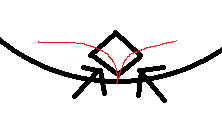Alex303
Civil/Environmental
- Sep 16, 2015
- 11
Hi, I have a 600NB Std Wt pipe that is full with water and supported every 5m. My question is whether or not the pipe requires a seat or whether it can just lay flat on a concrete pedestal? Obviously if it is sitting in a rounded pipe seat it would be better due to greater contact support on the pipe, but I am wondering how much better it is, more so out of interest?
If the pipe is lying flat on a plate or concrete pedestal you are basically allowing the pipe to deform and increase it's contact area on the plate as it does so. This means that the initial stress would be quite high, but then it would peter out as the contact point flattens. I would like to know whether the pipe has yielded in this zone (ie dented the pipe). I would also be interested in whether it was possible for the pipe to buckle in this loading case?
I have looked at table 14.1 on Roarks formulas which kind of describes my loading case, however that is only for a cylinder, not a pipe. I know shell analysis can get quite complex, but I was wondering whether someone had experience on how to calculate such a thing?
Unfortunately I don't have experience using any stress analysis programs otherwise I would just do that
Thanks
If the pipe is lying flat on a plate or concrete pedestal you are basically allowing the pipe to deform and increase it's contact area on the plate as it does so. This means that the initial stress would be quite high, but then it would peter out as the contact point flattens. I would like to know whether the pipe has yielded in this zone (ie dented the pipe). I would also be interested in whether it was possible for the pipe to buckle in this loading case?
I have looked at table 14.1 on Roarks formulas which kind of describes my loading case, however that is only for a cylinder, not a pipe. I know shell analysis can get quite complex, but I was wondering whether someone had experience on how to calculate such a thing?
Unfortunately I don't have experience using any stress analysis programs otherwise I would just do that
Thanks

